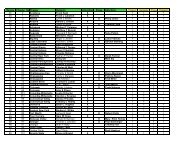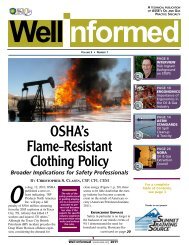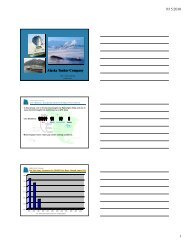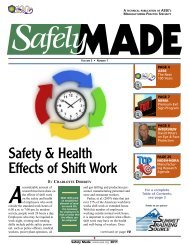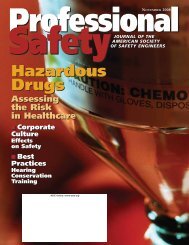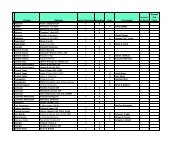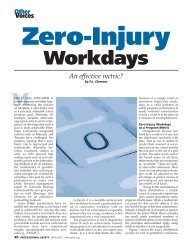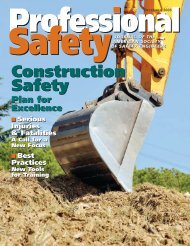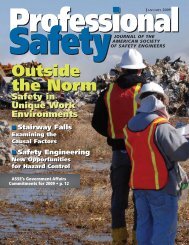ASSE Members - American Society of Safety Engineers
ASSE Members - American Society of Safety Engineers
ASSE Members - American Society of Safety Engineers
Create successful ePaper yourself
Turn your PDF publications into a flip-book with our unique Google optimized e-Paper software.
ANSI/<strong>ASSE</strong> Z590.2-2003<br />
AMERICAN NATIONAL STANDARD<br />
ANSI/<strong>ASSE</strong> Z590.2-2003<br />
Criteria for Establishing the Scope and<br />
Functions <strong>of</strong> the Pr<strong>of</strong>essional <strong>Safety</strong> Position<br />
June 2003<br />
ANSI/<strong>ASSE</strong> Z590.2-2003<br />
<strong>American</strong> <strong>Society</strong> <strong>of</strong> <strong>Safety</strong> <strong>Engineers</strong><br />
1800 E. Oakton Street<br />
Des Plaines, IL 60018<br />
(847) 699-2929<br />
www.asse.org<br />
A<br />
S<br />
S<br />
E<br />
AMERICAN SOCIETY OF<br />
SAFETY ENGINEERS
ANSI Z590.2-2003<br />
Foreword: (This foreword is not a part <strong>of</strong> <strong>American</strong> National Standard Z590.2-2003)<br />
The <strong>American</strong> National Standard Institute (ANSI) Z590 standard projects were initiated by the<br />
<strong>American</strong> <strong>Society</strong> <strong>of</strong> <strong>Safety</strong> <strong>Engineers</strong> (<strong>ASSE</strong>) in response to requests from its membership. After a<br />
careful evaluation <strong>of</strong> commentary from its membership in its various venues, consensus was reached<br />
for the <strong>American</strong> <strong>Society</strong> <strong>of</strong> <strong>Safety</strong> <strong>Engineers</strong> (<strong>ASSE</strong>) to initiate this standards project, including use<br />
<strong>of</strong> the canvass method approach. This methodology was chosen as the subject area <strong>of</strong> the standards,<br />
developed within the scope <strong>of</strong> the project, are primarily, but not exclusively, issues <strong>of</strong> <strong>ASSE</strong>'s mission<br />
and purpose. <strong>ASSE</strong> currently has almost 30,000 members representing a diverse range <strong>of</strong> safety<br />
pr<strong>of</strong>essionals from industry, business, government, and academia. This diverse membership, in<br />
conjunction with ANSI procedure, allows for development <strong>of</strong> such standards in a manner which<br />
encourages participation from a wide range <strong>of</strong> interested stakeholders.<br />
Using the <strong>American</strong> National Standards Institute (ANSI) model for the development <strong>of</strong> these<br />
standards, <strong>ASSE</strong> created the Operating Procedures (OPs) governing its role as secretariat.<br />
Concurrently, and integral to establishing the OPs, was registration <strong>of</strong> the standards project via the<br />
Project Initiation Notification System, which sought public comment <strong>of</strong> all interested and affected<br />
parties. While this notice was published in the ANSI Standards Action <strong>of</strong> November 7, 1997, the<br />
thirty (30) day notice expired on December 8, 1997 without any comment from the general public<br />
or affected/interested parties.<br />
Accordingly, and based upon this record and its procedural criteria, ANSI's Executive Standards<br />
Council approved establishment <strong>of</strong> the standards project, its operating procedures, and the <strong>ASSE</strong> as<br />
secretariat on February 12, 1998. Under the alphanumerical designation, Z590.1, and its title,<br />
Criteria for Establishing Levels <strong>of</strong> Competence in the <strong>Safety</strong> Pr<strong>of</strong>ession, various aspects related to<br />
the safety pr<strong>of</strong>ession are addressed. This second standard in the series is Z590.2 Criteria for<br />
Establishing the Scope and Function <strong>of</strong> the Pr<strong>of</strong>essional <strong>Safety</strong> Position.<br />
To perform their pr<strong>of</strong>essional functions, individuals practicing in the safety pr<strong>of</strong>ession generally<br />
have education, training and experience from a common body <strong>of</strong> knowledge. They need to have a<br />
fundamental knowledge <strong>of</strong> physics, chemistry, biology, physiology, statistics, mathematics, computer<br />
science, engineering mechanics, industrial processes, business, communication and psychology.<br />
Pr<strong>of</strong>essional safety studies include industrial hygiene and toxicology, design <strong>of</strong> engineering hazard<br />
controls, fire protection, ergonomics, system and process safety, safety and health program<br />
management, accident investigation and analysis, product safety, construction safety, education and<br />
training methods, measurement <strong>of</strong> safety performance, human behavior, environmental safety and<br />
health, and safety, health and environmental laws, regulations and standards. Many have<br />
backgrounds or advanced study in other disciplines, such as management and business administration,<br />
engineering, education, physical and social sciences and other fields. Others have advanced study in<br />
safety, and this additional background extends their expertise beyond the basics <strong>of</strong> the safety<br />
pr<strong>of</strong>ession.<br />
Because safety is an element in all human endeavors, the performance <strong>of</strong> these functions, in a variety<br />
<strong>of</strong> contexts in both public and private sectors, <strong>of</strong>ten employ specialized knowledge and skills.<br />
Typical settings are manufacturing, insurance, risk management, government, education, consulting,<br />
construction, healthcare, engineering and design, waste management, petroleum, facilities<br />
2
ANSI Z590.2-2003<br />
management, retail, transportation and utilities. Within these contexts, they must adapt their<br />
functions to fit the mission, operations and climate <strong>of</strong> their employer. Not only must individuals<br />
practicing in the safety pr<strong>of</strong>ession acquire the knowledge and skills to perform these functions<br />
effectively in their employment context, through continuing education and training they stay<br />
current with new technologies, changes in laws and regulations, and changes in the workforce,<br />
workplace and world business, political and social climate.<br />
As part <strong>of</strong> their positions, these individuals must plan for and manage resources and funds related to<br />
their functions. They may be responsible for supervising a diverse staff <strong>of</strong> pr<strong>of</strong>essionals. By<br />
acquiring the knowledge and skills <strong>of</strong> the pr<strong>of</strong>ession, developing the mind set and wisdom to act<br />
responsibly in the employment context, and keeping up with changes that affect the safety<br />
pr<strong>of</strong>ession, the required safety pr<strong>of</strong>essional functions are able to be performed with confidence,<br />
competence and respected authority.<br />
This standard (Z590.2) sets forth common and reasonable parameters <strong>of</strong> the pr<strong>of</strong>essional safety<br />
position. The standard will help businesses and industry in identifying areas <strong>of</strong> responsibility for their<br />
in-house practitioners <strong>of</strong> safety and outside safety consultants. In recent years legislation and<br />
regulation at the national, state, and local levels has attempted to codify the pr<strong>of</strong>essional areas <strong>of</strong><br />
responsibility for those practicing in the safety pr<strong>of</strong>ession. The most compelling reason why such an<br />
initiative should be undertaken is that <strong>ASSE</strong> identified hundreds <strong>of</strong> state and national<br />
legislation/regulation in a single calendar year which would have established these levels <strong>of</strong><br />
responsibility. Having one <strong>American</strong> National Standard will <strong>of</strong>fer a wide range <strong>of</strong> different options t o<br />
private sector organizations and public agencies in creating their own benchmark.<br />
<strong>American</strong> National Standard Z590.2-2003 uses a two-column format to provide both basic<br />
requirements and implementing information. The left column, "Standard Requirements," addresses<br />
the central principles and is printed in bold type. The right column, "Implementing Information,"<br />
<strong>of</strong>fers various criteria or approaches whereby the basic requirement is carried out in whole or part by<br />
the methodology set forth and described in the I-Column.<br />
Recognized job analysis methods are <strong>of</strong>ten used to derive the description <strong>of</strong> a practice in a field. Late<br />
in 2000, the Board <strong>of</strong> Certified <strong>Safety</strong> Pr<strong>of</strong>essionals (BCSP) completed a comprehensive job analysis<br />
study that involved about 1,500 safety pr<strong>of</strong>essionals, most <strong>of</strong> who are members <strong>of</strong> <strong>ASSE</strong>. The study<br />
identified and then validated through a survey twenty-four responsibility statements that describe<br />
pr<strong>of</strong>essional safety practice. Periodically, BCSP will conduct job analysis studies to ensure that the<br />
examinations leading to the Certified <strong>Safety</strong> Pr<strong>of</strong>essional (CSP) designation accurately reflect what<br />
safety pr<strong>of</strong>essionals do in practice. When one maps the responsibility statements from the BCSP<br />
study to the statements in this standard that describe the pr<strong>of</strong>essional safety position, there is a<br />
strong correlation between the two sets <strong>of</strong> descriptions. As a result, most would conclude that results<br />
<strong>of</strong> BCSP’s comprehensive job analysis study <strong>of</strong> pr<strong>of</strong>essional safety practice validate the descriptions<br />
<strong>of</strong> the pr<strong>of</strong>essional safety position that appear in this standard. The BCSP study is cited in the<br />
standard’s reference list.<br />
3
ANSI Z590.2-2003<br />
LIST OF THOSE PARTICIPATING IN THE DEVELOPMENT<br />
OF THE ANSI Z590.2 – 2003 STANDARD<br />
Those solicited and participating in the development <strong>of</strong> this standard are as follows:<br />
Northrup Grumman Emory Knowles<br />
Board <strong>of</strong> Certified <strong>Safety</strong> Pr<strong>of</strong>essionals Roger Brauer<br />
Frost Controls, Inc. Robert Thomson<br />
Board <strong>of</strong> Certified Pr<strong>of</strong>essional Ergonomists Dieter Jahns<br />
Human Factors and Ergonomics <strong>Society</strong> Lynn Strother<br />
National <strong>Safety</strong> Council Leo Carey<br />
Patton Boggs, L.L.P. Adele Abrams<br />
<strong>American</strong> Association <strong>of</strong> Occupational Health Nurses Anne R. Cox<br />
U.S. Mine <strong>Safety</strong> and Health Administration Kenneth Howard<br />
U.S. Occupational <strong>Safety</strong> and Health Administration Marthe Kent<br />
National Institute for Occupational <strong>Safety</strong> and Health David Votaw<br />
Indiana University <strong>of</strong> Pennsylvania Sam Gualardo<br />
<strong>American</strong> Industrial Hygiene Association Aaron Trippler<br />
U.S. Environmental Protection Agency Julius Jimeno<br />
National <strong>Safety</strong> Management <strong>Society</strong> Carl Griffith<br />
Integrated Project Management Co., Inc. L.E. Oldendorf<br />
Alliance <strong>of</strong> <strong>American</strong> Insurers Keith Lessner<br />
International Machinists and Aerospace Workers Michael Flynn<br />
Office <strong>of</strong> King County <strong>Safety</strong> and Claims William Hager<br />
National Ornamental/Misc. Metals Association J. Todd Daniel<br />
Association for Manufacturing Technologies South Florida Water Mgt. District<br />
Charles Carlson<br />
James Smith<br />
Enercron Services Travelers Insurance Company<br />
Michael Kinney<br />
John Cheffer<br />
Council <strong>of</strong> Engineering and Scientific Specialty Boards William Anderson<br />
Accrediting Board for Engineering and Technology George Peterson<br />
El Paso Natural Gas Company Fred Fleming<br />
Wente and Associates Frank Wente<br />
Granberry & Associates Edwin Granberry<br />
RRS Engineering Thomas Lawrence<br />
TOSCO Distribution Company Casey Conway<br />
Pr<strong>of</strong>essional <strong>Safety</strong> Consultants James Lapping<br />
CNA Insurance Company William E. Phillips<br />
Toledo Engineering Joseph Crawford<br />
Southeastern Oklahoma State University Robert Semonisck<br />
Construction <strong>Safety</strong> Council Thomas Broderick<br />
International Chemical Workers Union Council Michael Sprinker<br />
U.S. Army <strong>Safety</strong> Center Brenda Miller<br />
<strong>American</strong> Petroleum Institute William Erny<br />
Petroleum Education Council Jack Barnidge<br />
Tower Automotive Jerry Williams<br />
Cameron Corporation Frank Perry<br />
Board <strong>of</strong> Certified Hazard Control Management Consultant<br />
Harold Gordon<br />
Thomas Butler<br />
4
ANSI Z590.2-2003<br />
Visteon Auto Systems Drake Drobnick<br />
Frederic R. Harris, Inc. Richard R. Bourlon<br />
Hazards Limited Fred Manuele<br />
<strong>American</strong> Foundrymen's <strong>Society</strong>, Inc. Jimmie Childress<br />
Georgia Electric <strong>Members</strong>hip Corporation Anthony Watkins<br />
S&R Equipment Co., Inc. Guy Butts<br />
World <strong>Safety</strong> Organization Glenn Hudson<br />
Protective <strong>Safety</strong> Services Fred Weidner<br />
<strong>American</strong> Board <strong>of</strong> Occupational Health Nursing Sharon Kemerer<br />
Texas State Technical College David Day<br />
Vidal Engineering Keith Vidal<br />
Lithko Contracting Mike Hayslip<br />
USAA Hank Austin<br />
Environmental <strong>Safety</strong> Specialist William Jaeger<br />
Global Solutions Kathy Seabrook<br />
H<strong>of</strong>fman Construction Brian Clarke<br />
University Nevada/Reno David Lee<br />
Millersville University Paul Specht<br />
Weatherford International Mark Hansen<br />
Halliburton Company M.E. Greer<br />
Consulting <strong>Safety</strong> Engineer Jack Vetter<br />
Amoco Michael Thompson<br />
Luckhardt Group Jack Luckhardt<br />
Delphi Warren Brown<br />
ISP Corporation Douglas Pastore<br />
APIH Thomas Webb<br />
5
ANSI Z590.2-2003<br />
Z590.2 – 2003 STANDARD REQUIREMENTS<br />
1. Preface: Individuals practicing in the safety<br />
pr<strong>of</strong>ession endorse a proactive approach to the issue <strong>of</strong><br />
pr<strong>of</strong>essional responsibility. Numerous national/state<br />
agencies, private sector organizations, and standards<br />
development bodies are attempting to establish<br />
limitations, parameters, and baseline competence<br />
including standardization, regulations, and legislation.<br />
This standard sets forth the paradigm for those entities<br />
that establish competencies for the practice <strong>of</strong> safety and<br />
for reciprocity agreements between national/state<br />
regulatory agencies, legislative bodies, private sector<br />
organizations, and national consensus standards<br />
development bodies.<br />
2. Scope - Purpose - Application<br />
2.1 Scope: This standard establishes the scope and<br />
functions <strong>of</strong> the pr<strong>of</strong>essional safety position.<br />
2.2 Purpose: The purpose <strong>of</strong> this standard is to<br />
define the scope and functions <strong>of</strong> the pr<strong>of</strong>essional safety<br />
position.<br />
2.3 Application: The intent <strong>of</strong> this standard is to<br />
consolidate in a clear and consistent manner an objective<br />
assessment <strong>of</strong> the pr<strong>of</strong>essional safety position.<br />
2.3.1 Severability: If any <strong>of</strong> the provisions <strong>of</strong><br />
this standard are deemed to be not applicable, the other<br />
requirements or recommendations <strong>of</strong> the standard shall<br />
still apply.<br />
2.3.2 The intent <strong>of</strong> the standard is to establish<br />
criteria <strong>of</strong> the pr<strong>of</strong>essional safety position for use by<br />
employers, legislative bodies and regulatory agencies<br />
when establishing the responsibilities <strong>of</strong> individuals<br />
practicing in the safety pr<strong>of</strong>ession and to provide<br />
assurance to the public.<br />
2.4 Interpretations: The intent <strong>of</strong> this standard is to<br />
provide insight into the pr<strong>of</strong>essional safety position.<br />
Concerns, questions or inquiries should be directed to the<br />
secretariat.<br />
3. Scope and Functions <strong>of</strong> the Pr<strong>of</strong>essional <strong>Safety</strong><br />
Position: The scope and functions <strong>of</strong> the pr<strong>of</strong>essional<br />
safety position shall be to:<br />
• Anticipate, identify and evaluate hazardous<br />
conditions and practices.<br />
I.2.4: Inquiries should be addressed to Secretary, ANSI<br />
Z590, <strong>ASSE</strong>, 1800 E. Oakton Street, Des Plaines, IL<br />
60018.<br />
I.3: This standard specifically recognizes that the<br />
pr<strong>of</strong>essional safety position is not all-encompassing and<br />
that there is a great need for specialties and expertise,<br />
including such pr<strong>of</strong>essionals as industrial hygienists,<br />
occupational nurses, ergonomists, etc.<br />
6
ANSI Z590.2-2003<br />
• Develop hazard control designs, methods,<br />
procedures and programs.<br />
• Implement, administer and advise others on<br />
hazard controls and hazard control programs.<br />
• Measure, audit and evaluate the effectiveness <strong>of</strong><br />
hazard controls and hazard control programs.<br />
3.1 Anticipate, identify and evaluate hazardous<br />
I.3.1: This function involves:<br />
conditions and practices, as implemented in whole or in<br />
part by the methodology cited in I.3.1. I.3.1.1: Anticipating and predicting hazards<br />
from experience, historical data and other information<br />
sources.<br />
I.3.1.2: Identifying and recognizing hazards in<br />
existing or future systems, equipment, products,<br />
s<strong>of</strong>tware, facilities, processes, operations and procedures<br />
during their expected life.<br />
I.3.1.3: Evaluating and assessing the<br />
probability and severity <strong>of</strong> loss events and accidents,<br />
which may result from actual or potential hazards.<br />
I.3.1.4: Applying these methods and<br />
conducting hazard analyses and interpreting results.<br />
I.3.1.5: Reviewing, with the assistance <strong>of</strong><br />
specialists where needed, entire systems, processes and<br />
operational failure modes, causes and effects <strong>of</strong> the entire<br />
system, process or operation, or components due to:<br />
1. system, subsystem, or component failures;<br />
2. human error;<br />
3. incomplete or faulty decision-making,<br />
judgment or administrative actions; and/or<br />
4. weaknesses in proposed or existing policies,<br />
directives, objectives or practices.<br />
I.3.1.6: Reviewing, compiling, analyzing and<br />
interpreting data from accident and loss event reports<br />
and other sources regarding injuries, illnesses, property<br />
damage, environmental effects or public impacts to:<br />
1. identify causes, trends and relationships;<br />
2. ensure completeness, accuracy and validity <strong>of</strong><br />
required information;<br />
3. evaluate the effectiveness <strong>of</strong> classification<br />
schemes and data collection methods; and/or<br />
4. initiate investigations.<br />
I.3.1.7: Providing advice and counsel about<br />
compliance with safety, health and environmental laws,<br />
codes, regulations and standards.<br />
I.3.1.8: Conducting research studies <strong>of</strong> existing<br />
or potential safety and health problems and issues.<br />
7
ANSI Z590.2-2003<br />
I.3.1.9: Determining the need for surveys and<br />
appraisals that help identify conditions or practices<br />
affecting safety and health, including those that require<br />
the services <strong>of</strong> specialists, such as physicians, health<br />
physicists, industrial hygienists, fire protection<br />
engineers, design and process engineers, ergonomists,<br />
risk managers, environmental pr<strong>of</strong>essionals,<br />
psychologists and others.<br />
I.3.1.10: Assessing environments, tasks and<br />
other elements to ensure that physiological and<br />
psychological capabilities, capacities and limits <strong>of</strong><br />
humans are not exceeded.<br />
3.2 Develop hazard control designs, methods,<br />
procedures and programs, as implemented in whole or in<br />
part by the methodology cited in I.3.2.<br />
I.3.2: This function involves:<br />
I.3.2.1: Formulating and prescribing<br />
engineering or administrative controls, preferably before<br />
exposures, accidents and loss events occur, in order to:<br />
1. eliminate hazards and causes <strong>of</strong> exposures,<br />
accidents and loss events;<br />
2. reduce the probability and/or severity <strong>of</strong><br />
injuries, illnesses, losses or environmental<br />
damage from potential exposures, accidents and<br />
loss events when hazards cannot be eliminated.<br />
I.3.2.2: Developing methods that integrate<br />
safety performance into the goals, operations and<br />
productivity <strong>of</strong> organizations and their management and<br />
into systems, processes, operations or their components.<br />
I.3.2.3: Developing safety, health and<br />
environmental policies, procedures, codes and standards<br />
for integration into operational policies <strong>of</strong> organizations,<br />
unit operations, purchasing and contracting.<br />
I.3.2.4: Consulting with and advising<br />
individual and participating on teams:<br />
1. engaged in planning, design, development and<br />
installation or implementation <strong>of</strong> systems or<br />
programs involving hazard controls.<br />
2. engaged in planning, design, development,<br />
fabrication, testing, packaging and distribution<br />
<strong>of</strong> products or services regarding safety<br />
requirements and application <strong>of</strong> safety<br />
principles that maximize product safety.<br />
I.3.2.5: Advising and assisting human resource<br />
specialists when applying hazard analysis results or<br />
dealing with the capabilities and limitations <strong>of</strong><br />
personnel.<br />
I.3.2.6: Staying current with technological<br />
developments, laws, regulations, standards, codes,<br />
products, methods and practices related to hazard<br />
controls.<br />
8
ANSI Z590.2-2003<br />
3.3 Implement, administer and advise others on<br />
hazard control programs, as implemented in whole or in<br />
part by the methodology cited in I.3.2.<br />
I.3.3: This function involves:<br />
I.3.3.1: Preparing reports that communicate<br />
valid and comprehensive recommendations for hazard<br />
controls based on analysis and interpretation <strong>of</strong> accident,<br />
exposure, loss event and other data.<br />
I.3.3.2: Using written and graphic materials,<br />
presentations and other communication media to<br />
recommend hazard controls and hazard control policies,<br />
procedures and programs to decision-making personnel.<br />
I.3.3.3: Directing or assisting in planning and<br />
developing educational and training materials or courses<br />
involving hazard recognition and control; and<br />
conducting or assisting with courses related to designs,<br />
policies, procedures and programs involving hazard<br />
recognition and control.<br />
I.3.3.4: Advising others about hazards, hazard<br />
controls, relative risk and related safety matters when<br />
they are communicating with the media, community<br />
and public.<br />
I.3.3.5: Managing and implementing hazard<br />
controls and hazard control programs that are within the<br />
duties <strong>of</strong> the individual’s pr<strong>of</strong>essional safety position.<br />
3.4 Measure, audit and evaluate the effectiveness <strong>of</strong><br />
hazard controls and hazard control programs as<br />
implemented in whole or part by the methodology cited in<br />
I.3.4.<br />
I.3.4: This function involves:<br />
I.3.4.1: Establishing and implementing<br />
techniques involving risk analysis, cost, cost-benefit<br />
analysis, work sampling, loss rate and similar<br />
methodologies for periodic and systematic evaluation <strong>of</strong><br />
hazard control and hazard control program effectiveness.<br />
I.3.4.2: Developing methods to evaluate the<br />
costs and effectiveness <strong>of</strong> hazard controls and programs<br />
and measure the contribution <strong>of</strong> components <strong>of</strong> systems,<br />
organizations, processes and operations towards the<br />
overall effectiveness.<br />
I.3.4.3: Providing results <strong>of</strong> evaluation<br />
assessments, including recommended adjustments and<br />
changes to hazard controls or hazard control programs to<br />
individuals or organizations responsible for their<br />
management and implementation.<br />
I.3.4.4: Directing, developing or helping to<br />
develop management accountability and audit programs<br />
that assess safety performance <strong>of</strong> entire systems,<br />
organizations, processes and operations or their<br />
components and involve both deterrents and incentives.<br />
9
ANSI Z590.2-2003<br />
4. References and References to Other Standards<br />
4.1 Brochure: Scope and Functions <strong>of</strong> the<br />
Pr<strong>of</strong>essional <strong>Safety</strong> Position, <strong>American</strong> <strong>Society</strong> <strong>of</strong> <strong>Safety</strong><br />
<strong>Engineers</strong>, 1800 East Oakton Street, Des Plaines, IL<br />
60018.<br />
4.2 Job Analysis: Job Analysis Study for Certified<br />
<strong>Safety</strong> Pr<strong>of</strong>essional Examinations, Board <strong>of</strong> Certified<br />
<strong>Safety</strong> Pr<strong>of</strong>essionals, Savoy, IL 61874, BCSP Technical<br />
Report 2001-1, February 2001.<br />
10




